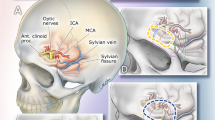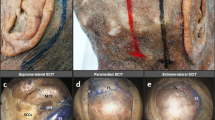Abstract
Minimally invasive transcranial approaches (MITAs) continue to expand in popularity in neurosurgery. Only few MITAs allow sufficient sylvian exposure to enable wide use of the transsylvian corridor. In this study, we aim to compare the transsylvian corridor in two MITAs: the minipterional (MPTa) and the extended supraorbital eyebrow approaches (XSEa). Eight cadaver heads were used to quantify the surgical exposure and maneuverability along the sylvian fissure and the insular lobe provided by the MPTa and the XSEa. Surgical exposure was calculated by means of the exposed length of the sylvian fissure and by the area framed within three extreme points in the insular lobe. Maneuverability was assessed by means of the surgical freedom along the sylvian cistern. XSEa provides twice the frontal exposure and half of the temporal exposure in comparison to the MPTa (p < 0.001 and p = 0.02, respectively). No significant differences were found between the two craniotomies in the length of the exposure of the sylvian fissure, area of insular exposure, or surgical freedom. Both the MPTa and the XSEa afford sufficient grades of exposure along the sylvian fissure and the insular lobe, although the viewing angle is significantly different between the two approaches. Such properties allow either to be used for microsurgery deep within the sylvian cistern. The use of additional corridors, such as the subfrontal route (XSEa) and pretemporal route (MPTa), may influence selection of either the minipterional or the extended supraorbital approaches according to the origin of the surgical pathology addressed.







Similar content being viewed by others
References
Almeida JP, Ruiz-Treviño AS, Shetty SR, Omay SB, Anand VK, Schwartz TH (2017) Transorbital endoscopic approach for exposure of the sylvian fissure, middle cerebral artery and crural cistern: an anatomical study. Acta Neurochir 159:1893–1907. https://doi.org/10.1007/s00701-017-3296-8
Ammirati M, Bernardo A (1998) Analytical evaluation of complex anterior approaches to the cranial base: an anatomic study. Neurosurgery 43:1398–1407; discussion 1407-1408. https://doi.org/10.1097/00006123-199812000-00081
Andrade-Barazarte H, Jägersberg M, Belkhair S, Tymianski R, Turel MK, Schaller K, Hernesniemi JA, Tymianski M, Radovanovic I (2017) The extended lateral supraorbital approach and extradural anterior clinoidectomy through a frontopterio-orbital window: technical note and pilot surgical series. World Neurosurg 100:159–166. https://doi.org/10.1016/j.wneu.2016.12.087
Chabot JD, Gardner PA, Stefko ST, Zwagerman NT, Fernandez-Miranda JC (2017) Lateral orbitotomy approach for lesions involving the middle fossa: a retrospective review of thirteen patients. Neurosurgery 80:309–322. https://doi.org/10.1093/neuros/nyw045
Cohen-Gadol AA (2020) Atraumatic sylvian fissure split: nuances and pitfalls. Oper Neurosurg (Hagerstown) 18:217–224. https://doi.org/10.1093/ons/opz074
Davies JM, Lawton MT (2014) Advances in open microsurgery for cerebral aneurysms. Neurosurgery 74 Suppl 1:S7–S16. https://doi.org/10.1227/NEU.0000000000000193
Elhadi AM, Hardesty DA, Zaidi HA, Kalani MYS, Nakaji P, White WL, Preul MC, Little AS (2015) Evaluation of surgical freedom for microscopic and endoscopic transsphenoidal approaches to the sella. Neurosurgery 11 Suppl 2:69–78; discussion 78-79. https://doi.org/10.1227/NEU.0000000000000601
Eroglu U, Shah K, Bozkurt M, Kahilogullari G, Yakar F, Dogan İ, Ozgural O, Attar A, Unlu A, Caglar S, Cohen Gadol AA, Ugur HC (2019) Supraorbital keyhole approach: lessons learned from 106 operative cases. World Neurosurg 124:e667–e674. https://doi.org/10.1016/j.wneu.2018.12.188
Figueiredo EG, Deshmukh P, Nakaji P, Crusius MU, Crawford N, Spetzler RF, Preul MC (2007) The minipterional craniotomy: technical description and anatomic assessment. Neurosurgery 61:256–264; discussion 264-265. https://doi.org/10.1227/01.neu.0000303978.11752.45
Flanigan P, Kshettry VR, Mullin JP, Jahangiri A, Recinos PF (2016) Frontal sinus morphometry in relation to surgically relevant landmarks in the United States population. World Neurosurg 91:12–15. https://doi.org/10.1016/j.wneu.2016.03.008
Heros RC (2011) The supraorbital “keyhole” approach. J Neurosurg 114:850–851; discussion 851. https://doi.org/10.3171/2010.6.JNS10878
Jeon C, Hong C-K, Woo KI, Hong SD, Nam D-H, Lee J-I, Choi JW, Seol HJ, Kong D-S (2018) Endoscopic transorbital surgery for Meckel’s cave and middle cranial fossa tumors: surgical technique and early results. J Neurosurg 131:1–10. https://doi.org/10.3171/2018.6.JNS181099
Martinez-Perez R, Albonette-Felicio T, Hardesty DA, Carrau RL, Prevedello DM (2020) Same viewing angle, minimal craniotomy enlargement, extreme exposure increase: the extended supraorbital eyebrow approach. Neurosurg Rev. https://doi.org/10.1007/s10143-020-01306-2
Martínez-Pérez R, Albonette-Felicio T, Hardesty DA, Prevedello DM (2020) Comparative anatomical analysis between the minipterional and supraorbital approaches. J Neurosurg:1–9. https://doi.org/10.3171/2019.12.JNS193196
Martinez-Perez R, Hardesty DA, Carrau RL, Prevedello DM (2020) The extended eyebrow approach a cadaveric stepwise dissection. Acta Neurochir 162:617–621. https://doi.org/10.1007/s00701-019-04203-w
Martinez-Perez R, Hardesty DA, Li R, Carrau RL, Prevedello DM (2020) Sylvian and insular exposure in the extended minipterional approach: landmarks, benefits, and quantitative analysis using a cadaveric study. World Neurosurg 138:e859–e866. https://doi.org/10.1016/j.wneu.2020.03.126
Martínez-Pérez R, Hernández-Álvarez V, Maturana R, Mura JM (2019) The extradural minipterional pretemporal approach for the treatment of spheno-petro-clival meningiomas. Acta Neurochir 161:2577–2582. https://doi.org/10.1007/s00701-019-04064-3
Martinez-Perez R, Joswig H, Tsimpas A, Poblete T, Albiña P, Perales I, Mura JM (2019) The extradural minipterional approach for the treatment of paraclinoid aneurysms: a cadaver stepwise dissection and clinical case series. Neurosurg Rev 43:361–370. https://doi.org/10.1007/s10143-019-01219-9
Martinez-Perez R, Mura JM (2019) The extradural minipterional approach: “think small, play wider.”. World Neurosurg 125:534–535. https://doi.org/10.1016/j.wneu.2018.10.240
Muhammad S, Tanikawa R, Lawton M, Regli L, Niemelä M, Korja M (2019) Microsurgical dissection of sylvian fissure-short technical videos of third generation cerebrovascular neurosurgeons. Acta Neurochir 161:1743–1746. https://doi.org/10.1007/s00701-019-03999-x
Raza SM, Quinones-Hinojosa A, Lim M, Boahene KDO (2013) The transconjunctival transorbital approach: a keyhole approach to the midline anterior skull base. World Neurosurg 80:864–871. https://doi.org/10.1016/j.wneu.2012.06.027
Reisch R, Perneczky A (2005) Ten-year experience with the supraorbital subfrontal approach through an eyebrow skin incision. Neurosurgery 57:242–255; discussion 242-255. https://doi.org/10.1227/01.neu.0000178353.42777.2c
Rychen J, Croci D, Roethlisberger M, Nossek E, Potts M, Radovanovic I, Riina H, Mariani L, Guzman R, Zumofen DW (2018) Minimally invasive alternative approaches to pterional craniotomy: a systematic review of the literature. World Neurosurg 113:163–179. https://doi.org/10.1016/j.wneu.2018.02.016
Sattur MG, Abi-Aad KR, Welz ME, Aoun RJ, Krishna C, Purnell C, Alghoul M, Bendok BR (2020) Extended lateral orbital craniotomy: anatomic study and initial clinical series of a novel minimally invasive pterional approach. J Neurol Surg B Skull Base 81:88–96. https://doi.org/10.1055/s-0038-1677470
Tra H, Huynh T, Nguyen B (2018) Minipterional and supraorbital keyhole craniotomies for ruptured anterior circulation aneurysms: experience at single center. World Neurosurg 109:36–39. https://doi.org/10.1016/j.wneu.2017.09.058
Welling LC, Figueiredo EG, Wen HT, Gomes MQT, Bor-Seng-Shu E, Casarolli C, Guirado VMP, Teixeira MJ (2015) Prospective randomized study comparing clinical, functional, and aesthetic results of minipterional and classic pterional craniotomies. J Neurosurg 122:1012–1019. https://doi.org/10.3171/2014.11.JNS146
Author information
Authors and Affiliations
Corresponding authors
Ethics declarations
Conflict of interest
Daniel M. Prevedello is a consultant for Integra LifeSciences Corp. and Stryker Corporation. Daniel Prevedello has equity on 3 rivers LLC, eLUM Technologies, LLC, and Soliton LLC. Daniel Prevedello receives royalties from ACE Medical, KLS Martin, and Mizuho.
Ethical approval and informed consent
Informed consent and ethical approval were not deemed necessary by the local ethics in view of the design of the study. Anatomical dissections, measurements, and analysis were performed at the Anatomical Laboratory for VisuoSpatial Innovations in Otolaryngology and Neurosurgery (ALT-VISION) at The Ohio State University.
Additional information
Publisher’s note
Springer Nature remains neutral with regard to jurisdictional claims in published maps and institutional affiliations.
Rights and permissions
About this article
Cite this article
Martinez-Perez, R., Beer-Furlan, A., Albonette-Felicio, T. et al. The transsylvian corridor through minimally invasive transcranial approaches: a comparative anatomical study. Neurosurg Rev 44, 2619–2627 (2021). https://doi.org/10.1007/s10143-020-01439-4
Received:
Revised:
Accepted:
Published:
Issue Date:
DOI: https://doi.org/10.1007/s10143-020-01439-4




